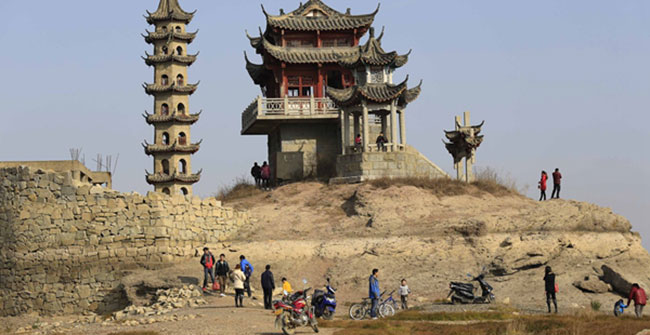Storm in a teacup?
By Hazel Knowles (China Daily HK Edition) Updated: 2012-09-05 10:38The scientific world is divided about predictions that global warming will result in more super typhoons on the scale of Typhoon Wanda for Hong Kong.
It was on September 1, 1962 that Typhoon Wanda roared into Hong Kong bringing hurricane winds and a tidal wave that reached between five and seven meters above sea level. By the time the storm and resulting storm surge had dispersed, more than 130 people had died, 53 were missing, and some 72,000 were homeless.
Today those statistics mean Wanda still holds the record as being Hong Kong's deadliest typhoon since the Second World War. By current classifications, adopted by the Hong Kong Observatory in 2009, she wasn't just a typhoon but a super typhoon, an extreme typhoon which carried sustained winds of at least 185 kilometers per hour.
It is a title Wanda shares with some of the most devastating storms in living memory including Hurricane Katrina which flattened New Orleans in 2005.
According to the observatory, only four other tropical cyclones having hit Hong Kong have earned the title of super typhoon since 1950. The others which qualify are Faye in 1963, Ruby in 1964, Roses in 1971 and Hope in 1979.
Typhoon Vicente in July, despite warranting a number 10 warning signal, was classified one stage below super typhoon as a severe typhoon; one which carried maximum sustained winds of between 150 and 184 kilometer per hour.
However, according to some scientific studies the odds of Hong Kong being hit by super typhoons on the scale of Wanda look set to get shorter as a result of global warming.
One such study carried out by the researchers from Nagoya University and the Meteorological Research Institute in Japan in 2009 claimed a projected 2 C rise in sea temperature in the western Pacific Ocean between 2074 and 2087 would lead to an increase of super typhoons.
A further report, made in 2010 by the Japan Agency for Marine-Earth Science and Technology and based on predictions made by a supercomputer, projected the number of global tropical cyclones would fall by 25 percent by the end of this century. Alarmingly, it predicted a 10-fold increase in the number of strong typhoons which would rise from the current average of around one every year to as high as 10 super typhoons a year.
The reasoning behind the global warming theory is that tropical cyclones gather energy from heat released as sea water evaporates as it warms up. The warmer the sea water, the more evaporation, and more energy to fuel the growth of a tropical cyclone.
This reliance on warm water explains why tropical cyclones — the technical name for both hurricanes and typhoons — strengthen as they travel over warm oceans and weaken once they reach a landmass.
According to Professor Johnny Chan Chung-leung, the dean of the School of Energy and Environment at City University Hong Kong, this is why the theory that global warming will bring more super typhoons seems logical at first thought.
However, Chan, who is considered a leading authority on typhoons, believes it is not correct and that it discounts the role played by wind in the formation of a typhoon.
"It is a very intuitive argument that many people have put forth and it does sounds obvious," said Chan.
"Tropical cyclones need warm water and if the ocean gets warmer because of global warming, then you may expect more storms. You may also expect more intense storms because it would derive more energy from the ocean.
"But it is not quite right because a tropical cyclone is not just clouds; it is a swirling mass of clouds. It has to spin around.
"Global warming will lead to higher water temperatures for sure. As a result there will be more cloud formation. But not all these blocks of clouds will be spun up into tropical cyclones.
"A tropical cyclone is a swirling system so therefore the clouds that form as a result of the temperature of the ocean have to be spun around. To spin them up you need to have winds that collaborate.
"If you say global warming will lead to more tropical cyclones or more intense tropical cyclones what you need to do is to prove that in a globally warmer world the winds will be spinning faster. No study has ever shown this spinning will become more intense with global warming."
Chan also points to the data of the last 50 years which shows that despite an average increase of around 0.5 C in oceans all over the world, the number of super typhoons has not increased.
"If you look at the number of storms in western north Pacific over the last 60 years when we have good data, we see a decreasing trend for tropical cyclones.
"In 2010, we had fewest tropical cyclones in the last 60 years. We had only eight typhoons when the average is 17 for the Pacific. If global warming is already at work you wouldn't expect such a result."
The Hong Kong Observatory is more cautious about the affects global warming will have on the intensity of typhoons. When questioned by the China Daily, it pointed to a special report jointly prepared by working groups of the Intergovernmental Panel on Climate Change — a scientific body comprising 195 member countries — which says the average intensity of tropical cyclones is likely to increase in a warming world, although increases may not occur in all ocean basins.
"While it remains uncertain whether climate change has any detectable influence on the tropical cyclone activity based on past observations in the western North Pacific basin, against the background of global climate change, most of the published modelling studies conducted by research groups around the world project increases in the tropical cyclone intensity and precipitation rates in the 21st century," said an Obvervatory spokesman.
Where the experts tend to agree, is that tropical cyclone activity appears to run in cycles with the yearly average number falling and declining over a 20 to 30 year period.
According to Chan, at present we are seeing the low activity stage of the cycle which accounts for below average number of cyclones in recent years.
"Why we have these cycles is a very good question. It is something we are scratching our heads over.
"At the moment we are sort of at the bottom end of the cyclone with less typhoons but some day in the next five to 10 years, it (the yearly average number) will come back up.
"This means we could see another Wanda. In the next 10 to 15 years you could see the number of tropical storms affecting Hong Kong increasing.
The theory about cycles would appear to be borne out by data from the Hong Kong Observatory statistics which shows the 30-year average decreases from the six to seven cyclones a year for the 30 year periods of 1961 to 1990 and 1971 to 2000 to between five and six for 1981 to 2010 period.
It also shows tropical cyclone activity in the South China Sea to be at a relatively quiet phase during the last two decades with the number 10 signal only been issued three times since the 1980s with Ellen in 1983, York in 1999, and Vicente in July this year.
Its spokesman said its analysis on the long term variations of the tropical cyclone activity in the South China Sea showed strong inter-annual and inter-decadal variations.
"For the long-term trend, there was a decrease in the tropical cyclone frequency in the South China Sea over the last few decades, but the trend is not statistically significant," it said.
This cyclical nature of cyclone activity is one of two reasons why Chan says we should not be complacent about typhoons — even if we accept that global warming will not affect the severity of tropical cyclones.
Secondly, the consensus among scientists is whatever the severity of the storm, the amount of rain from a tropical cyclone of any intensity will be more with global warming.
"I always use the comparison of a wet towel," said Chan. "If your towel is wetter and you squeeze it out there will be more water. By the same token if you have more water vapour in the atmosphere through global warming, you will be able to dump more rain.
"So even if the number of tropical cyclones is not going to increase, even if you have the same number, the amount of rain that is dumped on a place, whether it is Hong Kong or somewhere else, will be more. Then we have the consequence of flooding and landslides.
"If you look at many of the major cities, except those in US, wind is not the problem because the building structures are good, especially in Hong Kong where we have strict building codes. You are not going to have a building toppling over in a typhoon.
"Wind damage in many places is much less than flood damage. I work with insurance people and they tell me floods are much more of a problem to them than wind."
This increased rainfall could prove a problem in low-lying and flat areas such as the north western part of the New Territories and the Pearl River Delta, said Chan.
The experience of Hong Kong is that water in storms carries more potential for disaster than wind. Wanda's death toll of 183 was mainly the result of flooding and a storm surge at high tide which resulted in a 7 meter wave crashing through low-lying areas.
It is for these reasons, that Chan says we should never be complacent about typhoons and why the Observatory says it places public awareness of the potential threats of tropical cyclones as vital and on-going work.
"Members of the public should stay on the alert to the potential dangers associated with every tropical cyclone, such as high winds, heavy rain, storm surges, and swells," it said. "No matter whether the tropical cyclone is a super typhoon or not."
Waves of destruction
Wanda may be one of the most remembered super typhoons to hit Hong Kong, but she was by no means the most destructive or deadly according to records dating back further into history.
Wanda's death tally of 183 pales by comparison to the two typhoons which struck in 1906 and 1937.
Records kept by Hong Kong Observatory show these two nameless typhoons resulted in some 15,000 and 11,000 lives being lost respectively.
As with Wanda, it was water — more specifically the storm surge — not winds which were responsible for the majority of deaths.
The typhoon on September 2, 1937 — often named the Great Typhoon — resulted in the sea level rising to 1.8 meters above the predicted high tide and a 9.1 meter high tidal wave which swept through the narrow channel flood low-level villages in Tai Po and Shatin.
Around 870 acres of farmland was flooded and 300 sea vessels wrecked. Wind speeds were so powerful that they broke the Hong Kong Observatory's wind measurement instruments which stopped at 240 kilometer per hour.
Wanda's arrival in Hong Kong on September 1, 1962, also coincided with a high tide which also exacerbated the flooding in the New Territories causing a dramatic tidal wave which swept into Tolo Harbour, this time drowning 70 people.
The Hong Kong Observatory says casualties were lower with Wanda partly because of the timing with the 1937 arriving during the night, catching people unprepared, while Wanda hit in daylight.
Likewise, the city also had much more effective warning system and disaster prevention and mitigation measures in place which have continued to improve up to the present day.
Prepared for the worst
Electricity provider CLP is taking no chances with regard to super typhoons and whether more will come in Hong Kong's way in the future.
The company is in the middle of three-year project assessing the strength of its 700 transmissions towers to determine if they can stand up to the high winds which come with super typhoons.
A spokesperson said so far 151 towers have been identified which may need reinforcing at a cost of HK$1 million each.
"Due to the meteorological phenomena of El Nino, La Nina and global warming, the climate all over the world has become extraordinary, resulting in higher risk of super typhoon attacking Hong Kong," said the spokesperson.
"With reference to overseas experiences, super typhoons can result in tower deformation and collapse. To safeguard the reliability as well as the public safety, such risks should be properly mitigated and managed."
The new reinforced tower will be able to withstand wind gust of up to 300 kilometres per hour.
Other mitigating measures to combat adverse weather conditions include slope reinforcement and the installation of flooding alarm and water gates at low-lying sub-stations, plus regular typhoon drills.
It has also set up an Emergency Management Team responsible for overseeing and coordinating the emergency restoration works during the attack of super typhoon.
Typhoon Wanda in 1962 disrupted power supplies that affecting thousands, while two towers in Tuen Mun were damaged by Typhoon Ellen in 1983.
- Special troops to help keep China-Pakistan corridor safe
- New policies to aid Belt and Road business ventures
- Zika curbs to include mosquito mass extermination
- Xi visits old revolutionary base areas ahead of Spring Festival
- Nation in bid to ward off the Zika virus
- Li drops in for a chat at historic mosque
- Prison time reduced after 11 show they regret crimes
- PLA vows support, contributions to military reform
- Hainan looks to boost visitor numbers
- Excessive emissions a big problem in 59 cities







